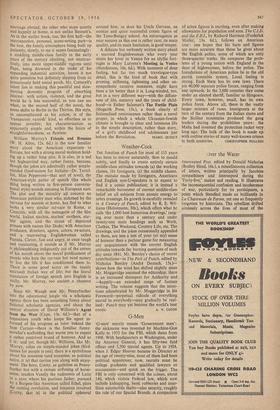G-Men
*G-MEN' merely means 'Government men': the nickname was invented by Machine-Gun Kelly in 1933 for the FBI, which dates from 1908. With headquarters at Washington, under the Attorney General, it has fifty-two field offices and 5,500 special agents. Up to 1924, when J. Edgar Hoover became its Director at the age of twenty-nine, most of them had been political appointees; now, recruits must be college graduates and qualified lawyers or accountants—and quick on the trigger. The FBI is only concerned with the .times, about 140, which violate Federal law, which now include kidnapping, bank robberies and inter- State automobile thefts—also security, roughly the role of our Special Branch. A comparison of crime figures is startling, even after making allowances for population and area. The C.I.D. and the F.B.I., by Richard Harrison (Frederick Muller, 13s. 6d.), follows an American tour: one hopes that his facts and figures are more accurate than those he gives about the English police, some of which are only three-quarter truths. He compares the prob- lems of a young nation with England in the days of highwaymen, before the police. The foundations of American police lie in the old parish constable system. Local feeling is strong. Each State has its own laws. There are 40,000 separate police forces, ranging from one upwards. In the 3,000 counties they come under an elected sheriff, familiar to filmgoers. Every town, however, small, has its own police force. Above all, there is the vastly larger mixture of races. Immigrants at the turn of the century from the Italian slums and the Sicilian mountains produced the gang leaders during the prohibition years: the Mafia had invented the protection racket very long ago. The bulk of the book is made up with outline stories of many well-known crimes


































 Previous page
Previous page